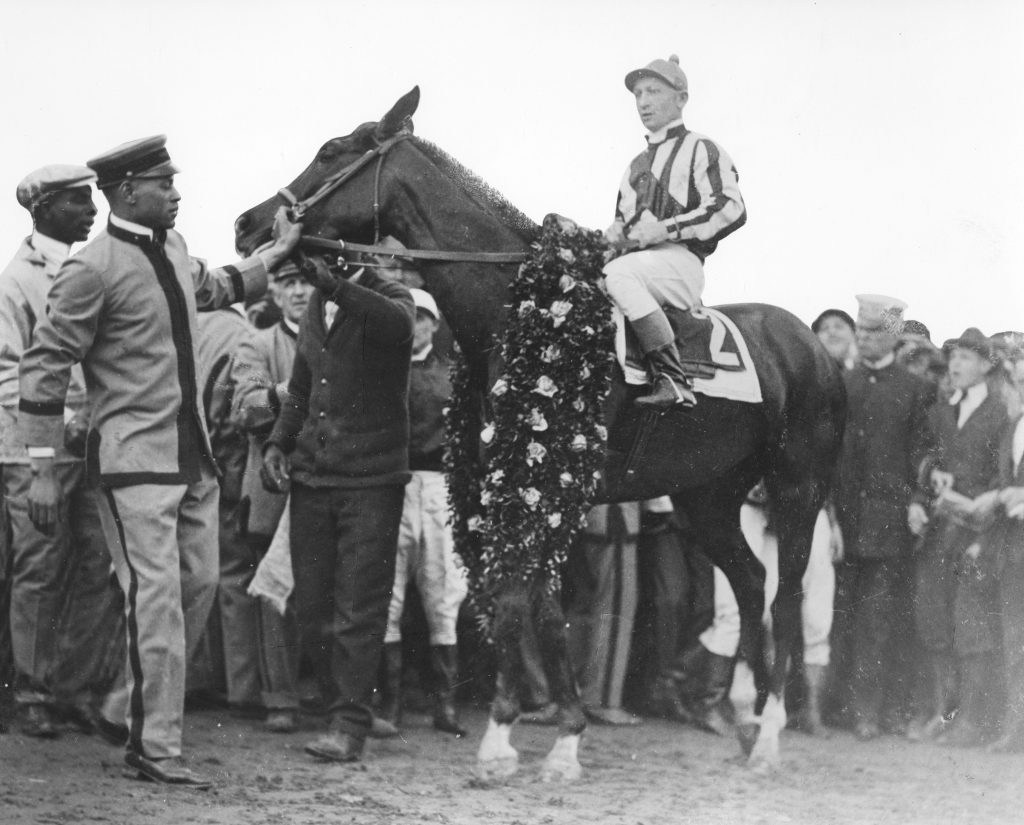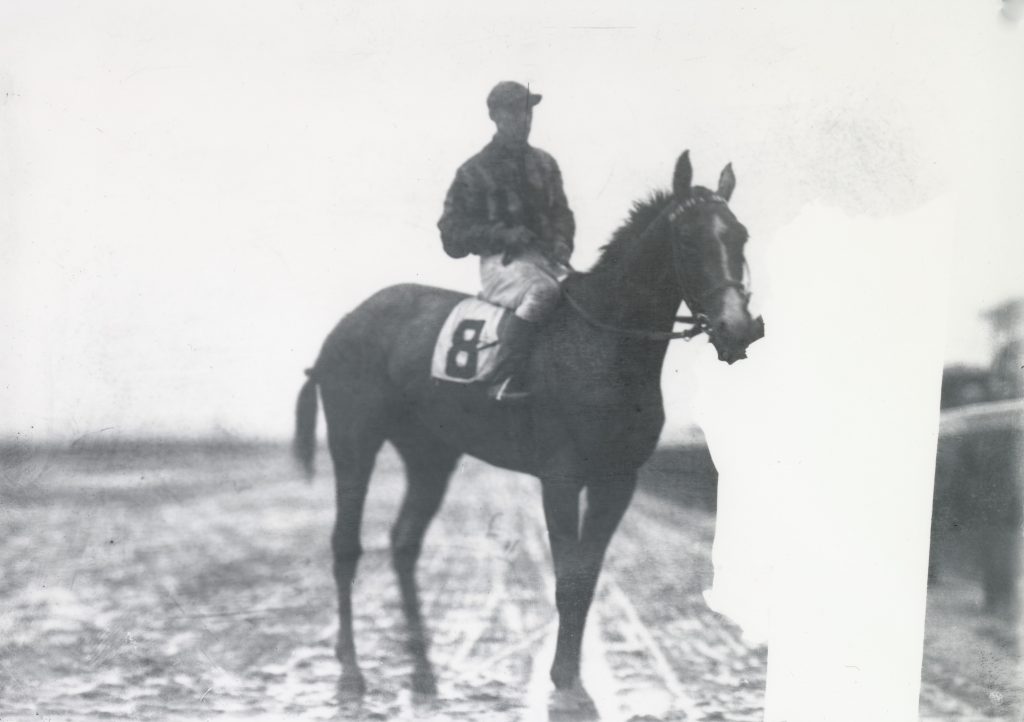
The 1920 Kentucky Derby was always going to be known for the name that didn’t appear on its nomination list. The name that was absent from the past performances. The most famous name in racing that didn’t grace the Kentucky Derby winner’s circle until 1929 long after he had stepped off the racetrack. No, the 1920 winner had the potential to elide attention for running in the shadow of the greatest racehorse the 20th century saw, but Paul Jones remains a name we know nevertheless. Even if his notability is solely from the happenstance of winning the Derby beneath the looming shadow of Man o’ War, Paul Jones remains a good horse who had his share of notable races over his five seasons.
A Beginning Rooted in Fortunes
Thomas Fortune Ryan had luck in his name – literally. Born in Virginia in 1851, Ryan spent his formative years in Virginia before the Civil War, attending school but not moving on to college. Seeing that little opportunity existed for him in Virginia, Ryan moved to Baltimore, Maryland where fortune found him in 1872.
John Barry, a dry goods merchant and Ryan’s future father-in-law, hired Ryan and then even secured the bright and charming young man a job as a brokerage assistant under William Collins Whitney. Fortune smiled on the young man once again; he was able to parlay his time with Whitney into his own brokerage firm. From there, Ryan built his wealth with ventures in transportation, insurance, tobacco, and more. When Thomas Fortune Ryan died in 1928, his estate was valued at over $200 million.
No doubt it was his time with Whitney that whetted Ryan’s appetite for Thoroughbreds. In 1909, he established a breeding operation at his Virginia estate, Oak Ridge, in Nelson County. He purchased twenty Irish mares and an English stallion, Sea King. Though Sea King himself was a stakes winner in England, it was his pedigree that made him an attractive addition to Ryan’s new stud. Sea King’s sire Persimmon had won two of the three English Triple Crown classics, the Epsom Derby and the St. Leger Stakes, and was the full brother to a Triple Crown winner, Diamond Jubilee (1900). Persimmon’s sire was St. Simon, the undefeated winner of both the Ascot and the Epsom Gold Cups and one of England’s most influential sires. Sea King’s dam Sea Air was sired by Isonomy, who sired two English Triple Crown winners, Isinglass (1893) and Common (1891). Sea King spent his stud career at Oak Ridge with periodic shuttles to other farms like Hamburg Place in Kentucky, where he spent a season in 1916.
Hamburg Place was the home of racing’s ‘Wizard of the Turf,’ John E. Madden. There, Madden would breed five Kentucky Derby winners and America’s first Triple Crown winner amongst the hundreds of winners that would come from his hallowed pastures. Among Madden’s broodmares at Hamburg Place in 1916 was a daughter of Hamburg, May Florence. A fair race horse, May Florence’s value lay in her pedigree as well: her dam Fiesole was out of the champion mare Firenze, who won multiple stakes races in open company in the late 19th century. As a race horse, Hamburg preferred to run on the lead and never finished out of the money in his 21 starts. May Florence may not have made a splash on the track, but pairing her with Sea King gave Madden a pedigree with the potential to win at long distances. The resulting foal was a brown colt with four white socks and a long blaze and a bit of a temper, Paul Jones.
Ral Parr had made his money as an insurance broker in Baltimore, Maryland, but, like so many men of means in this era, he turned his attention to his horses when his leisure time allowed such. His first winner was Uncle Jake, who won a county fair race at Timonium in 1895. Three years later, he had another winner at Sheepshead Bay in Brooklyn, New York and, after that his silks, black and white stripes with a red sash, were seen in the winner’s circle often enough that Parr became a fixture in the racing scene for the next three decades. He owned many winners, but he always searched for horses that could win him the classic races like the Kentucky Derby.
Parr’s trainer was William Garth, a fourth-generation horseman who was not only a trainer but an owner and breeder as well, running his own string of horses while also working for owners like Parr and partner Joshua Cosden, a Maryland native who had made his fortune during the oil boom of the early 20th century. John E. Madden held a yearling sale in New York in June 1918, the proceeds from this wartime sale going to the Red Cross. Garth attended the sale on Parr’s behalf, picking up that brown colt with a temper, one of eight by Sea King, for $1,000. They gelded him in the hopes it would quell some of that temper. It did make him easier to handle, but Paul Jones retained some of that challenging personality throughout his racing days.
As a team, Garth, Cosden, and Parr raced horses both on the flat and over jumps, running a string of two dozen or more horses at any given time, but their greatest success would come via that ornery gelding, the son of a fair sire and a well-bred dam, the unlikely champion
Unexpected Luck
At two, Paul Jones made his first start in April, finishing second in a four-furlong maiden sprint race at Bowie. Nine days later, he was back at the barrier for another maiden race – a claiming sprint of four furlongs. The Sea King gelding finished third behind Peter Combs, owned by Glen Riddle Farm and trained by Louis Feustel, the same team that would debut Man o’ War in June. Luckily for Ral Parr and Joshua Cosden, Paul Jones went unclaimed. He broke his maiden in his next start, just outlasting Kallipolis in the Aberdeen Stakes at Havre de Grace. The Aberdeen was the first of his wins on an off track, a recurring theme for the gelding throughout his career.

Paul Jones would win five of his twelve starts at age two, with two seconds and two thirds. His last start was a victory in a one-mile race for two-year-olds where the Parr-Cosden gelding set a track record of 1:41, which was not difficult to do since it was only the second time a one-mile race had been run at Havre de Grace. He did meet the juggernaut named Man o’ War once in 1919, finishing sixth and more than eight lengths behind the Riddle phenomenon in the Futurity at Belmont. Paul Jones may not have been spectacular at two, but he was in the money in 75% of his races that year. He had promise to be even better at age three.
The new year started off auspiciously for Paul Jones: he won a six-furlong sprint at Havre de Grace and then finished second in the Chesapeake Stakes. He was on the list of nominations for the Kentucky Derby alongside names like John P. Grier, Upset, Golden Broom, and his stablemate Blazes. Of the two Parr-Cosden nominees, Blazes was rated higher than Paul Jones and even seemed to be the choice of his owners. Among the colt’s victories in 1919 were the Grab Bag Handicap at Saratoga and the Breeders Futurity at the Kentucky Association track in Lexington. Those wins made Blazes one of those automatic favorites for the Kentucky Derby in 1920, so much so that Garth gushed about Blazes to the Daily Racing Form in March: “I have never had a horse winter better than Blazes has,” said Mr. Garth. “and I would not exchange chances for the Kentucky Derby with any man who has an eligible for the rate. I have sufficient confidence in Blazes to back him at even, play or pay, against any other candidate for the Derby.” They had so much confidence in the son of Wrack and Blazing Star that Parr had jockey Clarence Kummer, Man o’ War’s pilot for most of his three-year-old starts, on board for the Kentucky Derby.
As for Paul Jones, the gelding did not escape notice, even gaining some praise from writers like O’Neil Sevier, but was definitely not the name on everyone’s lips for the Parr-Cosden Derby chances. They had enough confidence in the gelding that they did tap Ted Rice, the jockey who had ridden the gelding in two of his victories, to ride him in the Kentucky Derby. After their prep races at Havre de Grace, Garth shipped the two to Churchill Downs and worked both over the mile and quarter route there in the days before the Derby. On May 3rd, Blazes and Paul Jones worked together, running the ten furlongs in 2:09 3/5. According to the Louisville Courier-Journal, Blazes finished the workout better than Paul Jones did and was “plainly the chief reliance of the barn.” A second workout at the same distance, though, showed that Blazes was more tired than his stablemate, perhaps shifting the stable’s fortunes from the Wrack colt to the Sea King gelding. Though Paul Jones did have some backing for finishing in the money, the Whitney entry of Upset, Damask, and Wildair were the favorite for most.
Man o’ War’s absence made the Kentucky Derby one of the few valuable races in 1920 that others had a chance at winning. As a result, 22 horses were entered, but the heavy track on the morning of May 8th trimmed the field back to a more manageable, but still unwieldy seventeen. William Garth told both of his jockeys as they prepared to mount their respective Derby horses to get away from the field at the break, take the lead, and do everything they could to stay there. How surprised must everyone had been when it was Paul Jones, not Blazes, that grabbed the lead and held it at every call. Breaking from post position two, toward the rail, Rice took advantage of Paul Jones’s fondness for an off track and vaulted him to the front, keeping a length or two ahead of the cavalry charge behind him while saving his horse for the rush of closers at the end. Upset, conqueror of Man o’ War in the 1919 Sanford, hung behind him stalking, and made his run at the gelding, gaining ground in the last furlong, but was unable to sustain his run to pass Paul Jones. Blazes never factored, leaving his stablemate to take the roses and a sweet purse of $30,375, almost half of the money Paul Jones would ultimately win in his career.
After the race, Ral Parr beamed from ear to ear, thrilled to win the most famous race in America and even richer than the big purse Paul Jones had scored. He won a $4,000 bet from the previous year that Blazes would not make it to the Derby – he did – and Parr had backed both Blazes and Paul Jones in the Kentucky Derby winter book, getting 100-1 odds on his gelding. Despite Sea King’s lackluster success at stud, he had sired a Kentucky Derby winner and Thomas Fortune Ryan had spread his luck beyond the breeding shed at Hamburg Place: John E. Madden had his third Kentucky Derby winner as a breeder and Parr, Cosden, and Garth had what would be their only Derby winner on their first try. In a year dominated by the irresistible juggernaut that was Man o’ War, Paul Jones managed to seize on his own bit of racing luck for a moment, only to have his Derby win discussed in terms of not what he did but who was absent from Churchill Downs that day.
His Luck Runs Out
A month after the Kentucky Derby, Paul Jones returned to the races in the Suburban Handicap. Because geldings were not eligible for the Preakness Stakes, he was forced to bypass a return to their home state and headed instead for New York. Rather than face Man o’ War in the Belmont Stakes, Paul Jones faced a field of four others in the mile-and-a-quarter Suburban, including Upset, the horse he narrowly beat in the Derby; Boniface, Commander J.K.L. Ross’s handicapper whose famous stablemates included Sir Barton and Billy Kelly; and the original game gelding himself, Exterminator. Like the Derby, the Suburban was run on an off track. Like the Derby, Paul Jones vaulted to the lead and stayed there at each call. Like the Derby, he tired in the last furlong and barely hung on to win by a head over Boniface. The Suburban was not the last race he won, but it would be the last significant victory of his career.
As a gelding, Paul Jones was not only ineligible for certain races, but he also had few options for a career after racing. With aftercare a concern that would come nearly a century later, he kept racing until it was clear he was no longer effective on the racetrack. The Sea King gelding raced for three more seasons, mostly in Maryland, factoring in several handicaps, but unable to rediscover that form that had brought him the Kentucky Derby and the Suburban. He retired in 1923 with a record of 14 wins, 12 seconds, and 13 thirds in 65 starts with $64,171 in winnings.
After his retirement, William Garth used him as a stable pony for some time until he went lame; the trainer opted to “nerve” him in the affected foot, which left Paul Jones with little feeling in that area and at greater risk for injury because he could not feel pain. Rather than put Paul Jones down, Garth gave him to his daughter, Berta. Her husband John Porter Jones retrained the gelding as a steeplechaser and rode him in several informal races. In 1930, at the age of thirteen, physical issues meant the end of Paul Jones, the Kentucky Derby winner who might not have won as many times as he ran, but, like fellow gelding Exterminator, raced long and often and always gave his best when he did. William Garth had continued to train and own horses in the years following Paul Jones’s Derby until ill health necessitated his retirement. Garth passed away in June 1934.

Ral Parr and Joshua Cosden continued to own horses in partnership until Cosden’s fortune became misfortune when he lost much of his money in the mid-1920s, forcing him to liquidate many of his assets. Though he did recover some of his fortune, Cosden died nearly penniless of a heart attack in 1940. Parr continued to own and race horses in Maryland for nearly two decades after Paul Jones’s Derby victory, serving as director of the Maryland Jockey Club, always seeking another horse he could send to America’s greatest race. He died of a stroke in October 1939.
A hundred years after his Derby victory, Paul Jones remains best known for his Kentucky Derby in the year of Man o’ War’s greatest triumphs. He outran a huge field of three-year-olds eager to capture this country’s most famous race, a victory that stands out not for who he did beat, but who he didn’t. Over his career, the gelding may not have had many more high profile victories, but, if nothing else, the name Paul Jones should invoke his legacy of giving each race his all, that innate gameness necessary to outlast his opponents to the wire.
Photos: Keeneland Library


